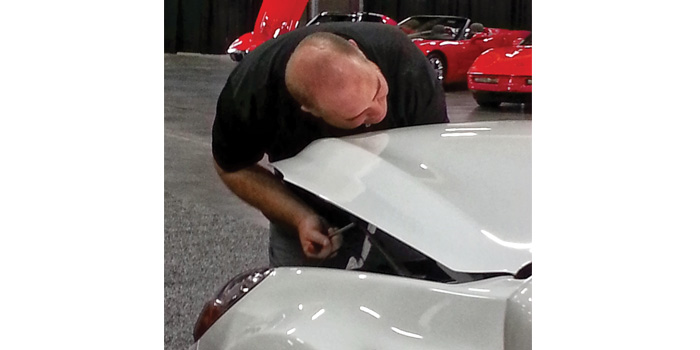“What is the best and simplest way to repair hail damage to a vehicle’s roof and hood?” – Jere Gore, owner, American Auto Collision, Detroit, Mich.
Determining the best and simplest method for repairing hail damage requires examining the methods available. We also need to look at the factors that go into deciding which method to use.
PDR
The first method is paintless dent repair (PDR). Most hail-damaged vehicles are repaired using PDR. This is not the kind of PDR where guys drill holes and cut braces out of panels, although some of those guys are still out there working on the “buy here, pay here” used car lots. Drilling holes in hail-damaged vehicles thankfully went out of style 15 years ago.
PDR is now done by an elite group of technicians who are interested in restoring a vehicle to true “pre-loss” condition. This method involves highly skilled technicians slowly massaging dents out individually using a variety of tools. Using specialized LED and fluorescent lighting, the technician works out all imperfections. The backside of the panel is then treated with a corrosion protection coating. This method has many advantages, including that it does not harm the OEM finish and has a quick cycle time.
Other Methods
Other methods of repairing hail-damaged vehicles include the conventional method of replacing top panels and then repairing side damage. When PDR is not a viable option, this is usually the preferred method. Sometimes a combination of the two methods is the best option. The top panels can be replaced and the side damage repaired using PDR.
Another option is called “push to paint.” This is usually on significant damage where paint may be split or there may be a couple dents that will not repair perfectly using PDR. Roofs and side panels are especially great candidates for this repair. The PDR technician repairs the panels to nearly perfect condition and then the panels are refinished using traditional repair methods.
Heating dents with a torch is a method that was used for many years, but today’s metals make this a poor choice for repairs because it will cause the panel to lose its tensile strength. A more modern take on this is the magnetic induction heater. Early models were sold as a PDR tool but were notorious for burning paint. Newer models have a timer built in to prevent this. However, there is some concern as to the heat created, causing the repaired area to lose its tensile strength.
Which Method?
Deciding which method to use depends on several variables. One is the condition of the vehicle. If the paint is badly faded or has poor previous repairs, it may prohibit PDR repairs and necessitate conventional repairs.
The interior condition of the vehicle also comes into play as the headliner will most likely need to be removed.
Panel material is also a consideration. Today’s vehicles use steel, aluminum and high-strength steel. The most obvious factor in deciding the method of repair is the severity of the hail damage. Every vehicle should be evaluated on a case-by-case basis.
Skilled PDR
Generally, PDR preformed by a skilled technician is the preferred repair. There may be factors that preclude this method and call for a conventional repair.
Your shop should have a credible, certified PDR provider. It has proven to be a very profitable income stream and welcome addition to most shops.
Most shops sublet PDR repairs to a local PDR provider. Catastrophic hail events are usually handled by teams specializing in hail damage that network with the local PDR provider or the shop directly. Shops that have utilized local PDR providers networking with hail damage teams have the added benefit of having a local company to deal with if any issues arise at a later date.
The PDR industry has formed a non-profit trade association, the National Alliance of Paintless Dent Repair Technicians (NAPDRT). The industry also has developed skills-based certification through Vale Training Solutions. The PDR industry has matured, and its benefits have been proven. In recent years, PDR has been embraced by manufacturers and the collision industry.














